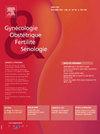Application en routine des résultats d’un essai randomisé : performance de l’échographie en pratique courante pour le dépistage de la macrosomie fœtale
IF 0.6
4区 医学
Q4 OBSTETRICS & GYNECOLOGY
引用次数: 0
Abstract
Objective
To evaluate the performance of ultrasound at 36 weeks of gestation for screening fetal macrosomia according to the criteria of the randomized “DAME” trial.
Method
Retrospective observational study over 2 years in a type 3 maternity hospital. The primary outcome was birth weight above the 97th percentile on Audipog birth weight curves. The sensitivity, specificity, positive and negative predictive value of ultrasound at 36 SA for predicting macrosomia were calculated. For each patient, the absolute value of the difference between actual and estimated weight [EPF difference = (Birth weight − Estimated weight)/Birth weight] was calculated. Among undetected macrosomic newborns (≥ 97th Audipog percentile), risk factors associated with misdiagnosis were investigated (false negatives versus true positives).
Results
Ultrasound estimation of fetal weight at 36 SA to detect fetal macrosomia had a sensitivity of 43.7% and a specificity of 82.1%. With a positive predictive value for ultrasound of 36,9% and a negative predictive value of 85.8%. The mean absolute value of the difference between estimated and actual birth weight was 287 g (95% CI [115–409]), with a mean relative difference of 6.8% (95% CI [3.0–11.3]). A relative difference of less than 10% between the estimated weight and the birth weight was found in 68.5% of the patients. Among macrosomic newborns (≥ 97th percentile), a third-trimester estimated fetal weight at or above the 90th percentile, along with a history of fetal macrosomia in a previous pregnancy, reduced the risk of false negatives in the screening ultrasound at 36 weeks of gestation.
Conclusion
Ultrasound performed at 36 weeks’ gestation in a population targeted for suspected fetal macrosomia in routine practice has moderate sensitivity and positive predictive value. It would be timely for teams also applying this protocol to share their results, in order to verify whether or not our findings can be generalized to a larger scale.
[随机试验结果的常规应用:超声波在日常工作中筛查胎儿巨大儿的效果]。
目的根据 "DAME "随机试验的标准,评估妊娠 36 周超声波筛查胎儿巨大儿的性能。方法:在一家三甲妇产医院进行为期两年的回顾性观察研究。主要结果是出生体重超过奥迪波出生体重曲线第97百分位数。计算了 36 SA 超声波预测巨大儿的敏感性、特异性、阳性预测值和阴性预测值。计算每位患者实际体重与估计体重之差的绝对值(EPF 差=(出生体重-估计体重)/出生体重)。在未发现巨大儿的新生儿中(≥97th Audipog 百分位数),研究了与误诊相关的风险因素(假阴性与真阳性)。结果:用超声估测怀孕 36 周时胎儿的体重来检测胎儿巨大儿的敏感性为 43.7%,特异性为 82.1%。超声的阳性预测值为 36.9%,阴性预测值为 85.8%。估计出生体重与实际出生体重之间差异的平均绝对值为 287 克(95% CI [115-409]),平均相对差异为 6.8%(95% CI [3.0-11.3])。68.5%的患者估计体重与出生体重的相对差异小于10%。在巨型新生儿(≥97百分位数)中,第三孕期估计胎儿体重达到或超过90百分位数,以及既往妊娠有巨型胎儿史,可降低妊娠36周超声筛查的假阴性风险:结论:在常规临床实践中,在妊娠 36 周时对疑似巨大胎儿的目标人群进行超声检查具有适度的敏感性和阳性预测值。同样采用该方案的团队应及时分享他们的结果,以验证我们的发现是否可推广到更大范围。
本文章由计算机程序翻译,如有差异,请以英文原文为准。
求助全文
约1分钟内获得全文
求助全文
来源期刊

Gynecologie Obstetrique Fertilite & Senologie
Medicine-Obstetrics and Gynecology
CiteScore
1.70
自引率
0.00%
发文量
170
期刊介绍:
Gynécologie Obstétrique Fertilité & Sénologie est un mensuel scientifique d''information et de formation destiné aux gynécologues, aux obstétriciens, aux sénologues et aux biologistes de la reproduction. La revue, dans ses éditoriaux, articles originaux, mises au point, lettres à la rédaction et autres rubriques, donne une information actualisée ayant trait à l''obstétrique et à la gynécologie et aux différentes spécialités développées à partir de ces deux pôles : médecine de la reproduction, médecine maternelle et fœtale, périnatalité, endocrinologie, chirurgie gynécologique, cancérologie pelvienne, sénologie, sexualité, psychosomatique…
 求助内容:
求助内容: 应助结果提醒方式:
应助结果提醒方式:


